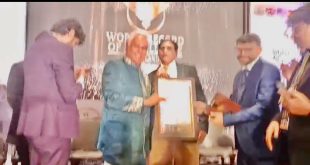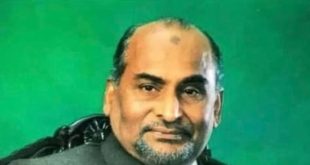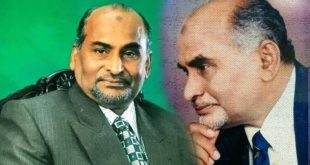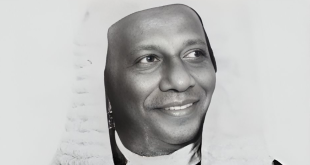
A.M.A.Azeez was born in Jaffna in 1911 and died in Colombo in 1973. His comparatively short life of 62 years forms a captivating swathe in modern Sri Lankan history.Viewed as a whole, perhaps its greatest lesson is as a metaphor for Nation Building. Juxtaposing Azeez’s lifework besides the needlepoint in time that we are poised today, we thought it appropriate to explicate this theme for our collective reeducation. Azeez is a superb role model at a time when authentic Nation Builders are rare. It is here that Azeez emerges as An Iconic Nation Builder. He merits the studious attention of every single Sri Lankan.
There is a difference between this analysis of Azeez and the numerous appreciations of his life and work written by many hands over the years. We find that since Azeez’s achievement is so diverse and multi-faceted, there is quite an understandable propensity for writings about him to selectively deal with one or two prominent aspects of his vast achievement. While paying homage to this great son of Sri Lanka, such an approach seems to miss out on a unique quality of his significance. That is to approach his lifework as one tightly interwoven narrative. Azeez brought an integrated moral and spiritual integrity, a rigorous intellectual acuity and a total commitment to every single phase of his career. The metaphor of Nation Building lies in this sum total viewed in its holism.
History placed Azeez’s career in the most strategic of times. The first thirty six years of his life, were deeply entrenched in the first four decades before Independence, when Sri Lanka was negotiating the first phase of its Nation Building trajectory from fully-fledged colonialism through modern nationalism to independence. As we shall see later, he was caught in its tension as a colonial Civil Servant. The last twenty five years were spent after Independence. Both these phases may be said to have posed ‘cruel’ challenges to him in the sense that he was called upon to make decisions that either furthered or undermined Nation Building. This is where he excelled – every single decision he made, eloquently underwrote the pre-eminent Nation Building compulsion.
Further, there is an unenviable symmetry to his career. It seamlessly divides itself into four phases which facilitate critical evaluation. Phase one, from birth to 1933, is a period of growth and preparation for national service. The second phase from 1935 to 1948 is in the Ceylon Civil Service. The next thirteen years from 1948 to 1961, involves two parallel roles as Principal of Zahira College, Colombo, as well as a member of the Senate. The last years or fourth phase was as a member of the then prestigious Public Service Commision from 1963 to 1970 and the period of his greatest literary output in Tamil and English during 1962 and 1973. The spirit and substance of Nation Building runs through all phases. Each phase marks a deepening and consolidation of the phase before. Symmetry is indeed the right word for such a trajectory.
THE JOURNEY OF THE SELF
Azeez’s life is one of continuously scaling heights. How did he do it? It is that method and process that we refer to in the title, The Journey of the Self. His growth into adulthood was marked by a process of inner growth. The term Self, connotes this particular experience of personhood which is a holistic concept. It works through a process of critical dialogue with one’s Self. The benefit is in internalizing particular capacities. It is a process of psychological maturing. He acquired these capacities throughout his childhood, and later, through family and human relationships. The result was enrichment in intellectual perspicacity and self-confidence.
Also The Journey of the Self applies in two complementary senses. The first is the journey of the Self in the early years of childhood, boyhood, university and adulthood. The second sense is larger and bigger. It refers to the journey of enhancing the inner person and its capacities, throughout his life. It is this second process which enables him to successfully address newer and bigger challenges as he plays multiple roles in complex circumstances.
Marina Ismail recreates for us this touching early period of childhood and boyhood. “He wished to impress on us that the simple way of life with love, affection and understanding among the family members which he had experienced, was far superior to all the wealth in the world. He also wanted to emphasise that life was not all a bed-of-roses for him and that he had to work hard to achieve his ideals which made his life meaningful” He lost his mother when he was seven, but this loss was compensated in ample measure by the love showered on him by his maternal grandparents and aunt who really brought him up. There is absolutely no doubt that he enjoyed a childhood with an abundance of emotional bonding.Azeez “would study late into the night with the aid of a flickering oil lamp, while Ummamma (The grandmother) feeling concerned about him and wishing to keep company, sat nodding away in a corner”. Again she says ”The children who lived down Mohideen Mosque Lane played, learnt their lessons and prayed at the nearby mosque. The boys regularly attended prayers dressed in checked sarongs, white shirts and distinctive white skull-caps. Much time was spent in religious instruction at the Allapichai Madrasa which later became Muhammadiya Mixed School, and it was at this early stage that my father began to have a deep respect for religion, a respect he instilled in us.” Or ”The lane was their playground”. Though the grandfather could have afforded to send him to school in a buggy cart “my father had to walk the one-and-a-half miles to and from from school every day. This was indeed an enjoyable trip, for all the boys walked together laughing and chatting”. The boys were Muslim and Hindu. Not even a whiff of present day segregation.
As Prof. Ryhana Raheem perceptively observes, when he returned to his boyhood school in 1963 for its Golden Jubilee Address, he did not talk about Cambridge or University College but about his first school.”I now feel thrice-blessed that I did go to Vaidyeshwara Vidyalaya and nowhere else. My period of stay, February 1921 to June 1923, though pretty short quantitatively was extremely long qualitatively. It was at Vidyalaya that I became first acquainted with the devotional hymns of exquisite beauty and exceeding piety for which Tamil is so famed through the ages and throughout the world.” After Vaidyeshwara, he went to Jaffna Hindu College. He often quoted Prophet Muhammad’s “Seek knowledge from the cradle to the grave “ and Francis Bacon who said “Knowledge is Power”.
Azeez’s was a modern mind .His attitude to women’s education is significant. He believed that girls must receive modern education upto the highest levels. He strongly advocated his daughter going to Peradeniya University and on the eve of her departure told her: ”I should be happy with my studies: should not think of material benefits, but read the subjects one liked and try to do one’s best.” Enlightenment rings through these words. He set further examples with girls in his extended family. He did not believe in Purdah, though he stood for modesty in women’s dress. He disapproved of the conventional dowry system for girls .
Azeez was an Exhibitioner in the University College in Colombo, having entered it in 1929. He did History Honours and passed out with an Upper Second class. In his homage to his dear friend and colleague, C. Vanniasingam, he reveals that the intention while at university was to become a lawyer. Additionally, he won that year’s (1933) one and only Government Arts Scholarship to continue his studies in England, where he proceeded to St.Catherine’s College, Cambridge in 1934. However before sailing for England, he had sat for his Ceylon Civil Service examination. Within a month of being at Cambridge, he heard that he had passed the Ceylon Civil Service and decided to take up that appointment and immediately returned to the island. He was the first Muslim to enter that Service.
In tracking his personal journey, we should be mindful of the nature of these times. These were the inter-war years when revolutionary change was reverberating in the world at large, especially in the colonial societies. The Russian Revolution and its inspiration, the Great Depression and the conflicts in Germany, the awakening in China and Japan,and the Indian Independence Struggle were all revolutionary events. Within Sri Lanka too, there were historic changes happening. Particularly the effects of the Donoughmore Commission and the granting of universal franchise, with the consequential election of the first and second State Councils. This period of the two Councils, from 1932 to 1947, saw the determined unfolding of a process of countrywide change in all aspects of governance and development. However, there was one very significant gap – a structural gap – in these propitious change processes, and that was Nation Building. That was missed out and submerged in the rhetoric and realpolitik of the lead-up to Independence. We have analysed this elsewhere in detail and called it “the absent fundamental” in our polity. This is what makes Azeez’s achievement, together with a few other exceptional persons ahead of his times, very special. Azeez , who was very much in the mainstream of intellectual and policy making in his society, due to the strength and tenacity of his vision for Sri Lanka, succeeded in manoevring his way in the polity, consciously and deftly avoiding the pitfalls in the path of Nation Building. In fact that is the narrative that we are celebrating today.
This is where Azeez’s intellect towers above the mainstream. It is facile to say that his study of history had armed him against these dangers. It was, as we are striving to show, something much larger and more whole. His whole make-up was different and composed to produce a very different kind of outlook. To put it simply, he saw Sri Lanka – and himself -in a very different way. It is that we have to understand. Let us now move to the next important transition, which will reveal a lot more.
Please Click here to read the complete Article![]()
Covers of all books written by Dr.Azeez and on him.
no images were found
Post Disclaimer | Support Us
Support Us
The sailanmuslim.com web site entirely supported by individual donors and well wishers. If you regularly visit this site and wish to show your appreciation, or if you wish to see further development of sailanmuslim.com, please donate us
IMPORTANT : All content hosted on sailanmuslim.com is solely for non-commercial purposes and with the permission of original copyright holders. Any other use of the hosted content, such as for financial gain, requires express approval from the copyright owners.
 Sri lanka Muslims Web Portal Sri Lanka Muslims News Center
Sri lanka Muslims Web Portal Sri Lanka Muslims News Center




Assalamu Alaikum Warahamathullahi Wabarakathuhu
Alhamdulillah, I was present at the oration and it was one of the best speeches ever done of Dr A.M.A.Azeez. It was amazing the way Mr Susil Sirivardana analyzed various phases of Dr Azeez’s life and his contribution toward Nation Building. It is an eye-opener for the present leaders.
I take this opportunity to thank Mr Sirivardana on his splendid oration. Well done Susil.